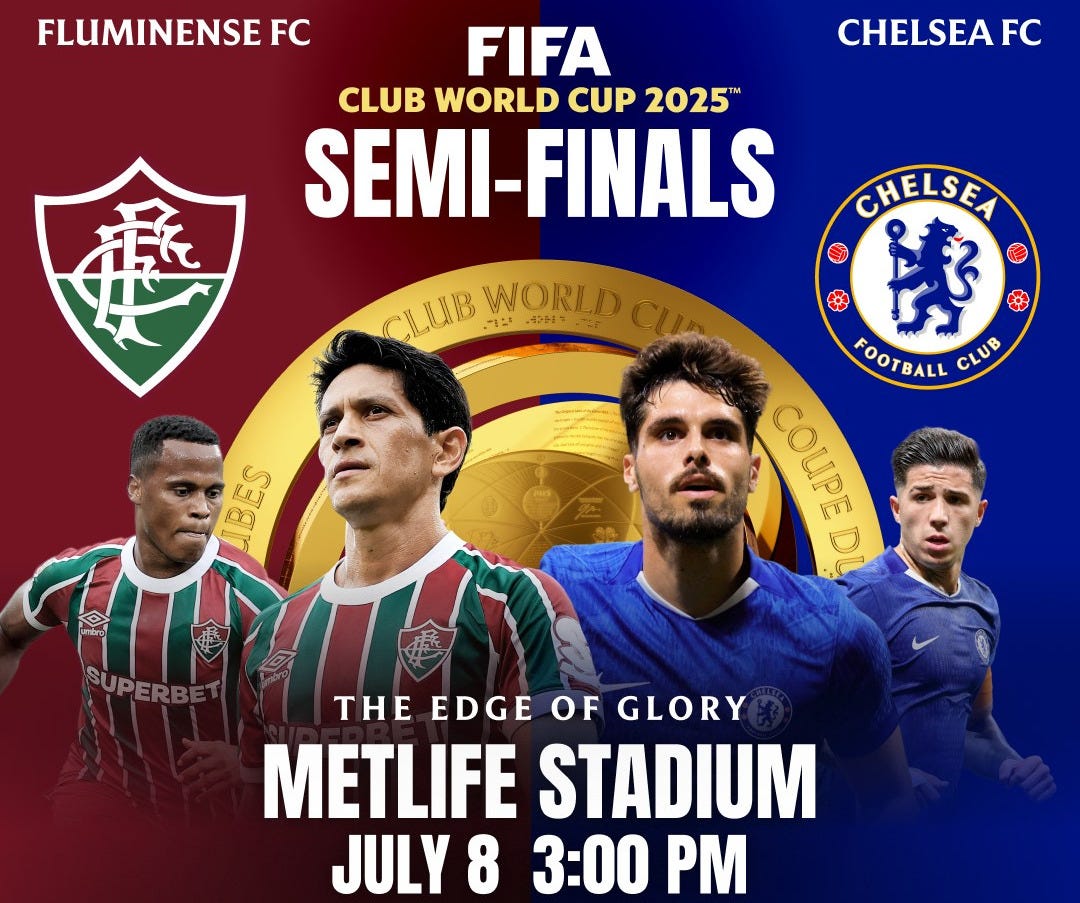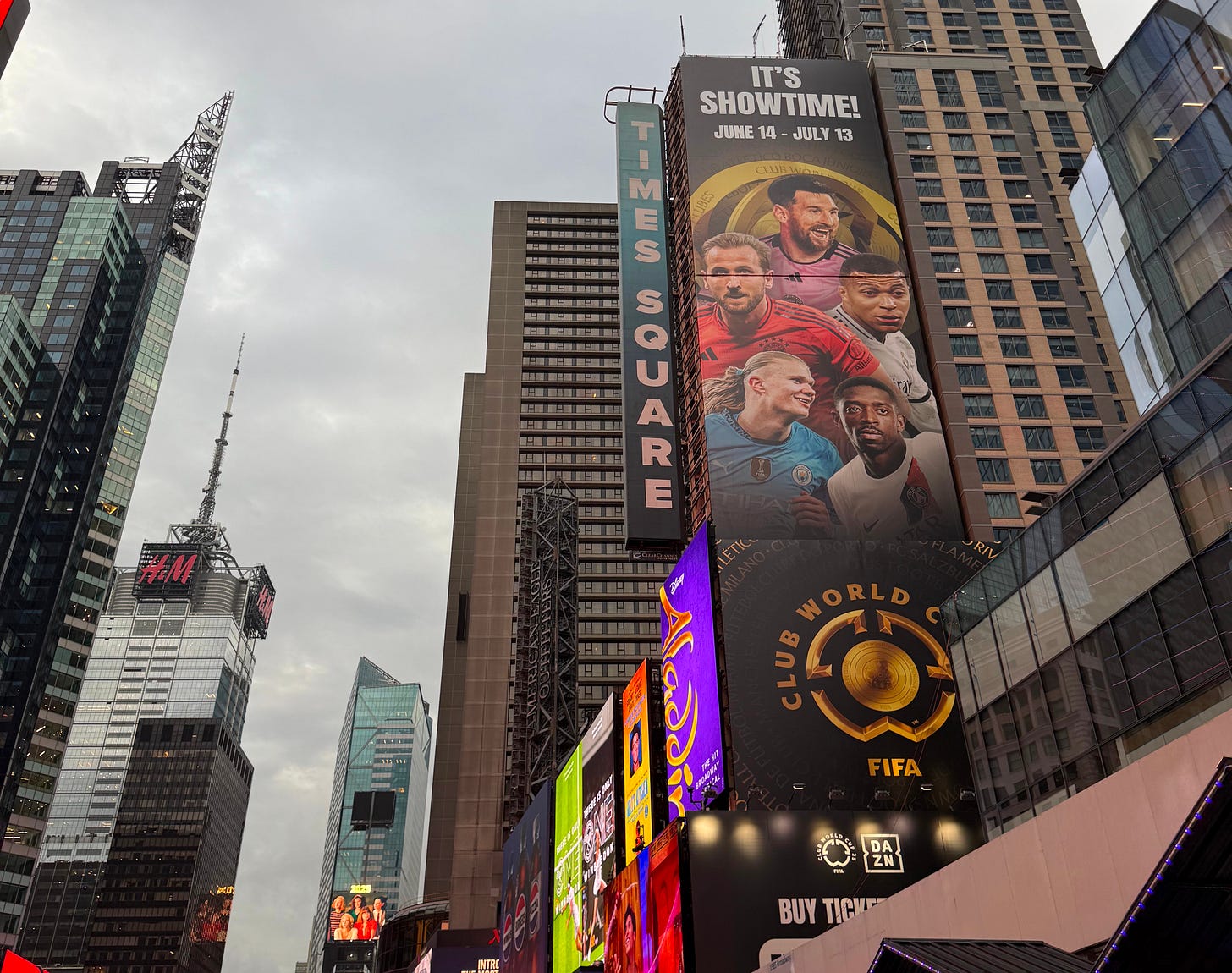Club World Cup? What Club World Cup?
In the heart of New York City, Chelsea face Fluminense in a global semi-final that barely registers. FIFA’s banner is up in Times Square, but the game feels miles away.
A Game in the City That Doesn’t Know It’s On
I’m writing this at 5am in New York. Jet lag has done what no amount of sightseeing could — slowed me down. The family are still fast asleep, the hum of the air con competing with the occasional siren from the street below. I’m sat with a lukewarm hotel coffee, watching the sky lighten, and thinking about a match that barely seems to exist here.
Later today, at 3pm local time, Chelsea will face Fluminense in the semi-final of FIFA’s Club World Cup. It’s being played at MetLife Stadium, one of the great sporting arenas in the United States. And yet, unless you’re actively looking for it, you’d barely know it was happening.
That said, I did spot an advert in Times Square — a solitary nod to the tournament, hanging above the chaos and the lights. It stood out more for its rarity than its impact. No other signs. No fan zones. No fever. No feeling. One banner on a corner of the most photographed junction in the world, and that was it.
For a game with this billing, in a city this big, it all feels strangely muted.
The Numbers That Don’t Add Up
When I checked ticket prices last night, curiosity gave way to disbelief. Even after FIFA’s desperate weekend markdowns, the cheapest seats were still $60 and those are up in the third tier, so far from the pitch you’d need binoculars and a neck brace. Want a view that doesn’t involve oxygen masks? That’ll be $400 or more. Per person. Before you even think about transport, food or drinks.
We’ve got four of us here. Two kids. You start adding it all up and, before long, it’s an expensive afternoon in the middle of a heatwave, with very little guarantee of any atmosphere at all.
Yes, the prices were slashed. But only after the early birds had paid hundreds for their seats. You’ve got supporters who shelled out top dollar now seeing those same tickets available for a fraction of the cost. No refund. No apology. Just another reminder of how this tournament has been handled.
Football as Product, Not Passion
This was supposed to be FIFA’s new showpiece. An expanded Club World Cup in the land of the Super Bowl and the skyscraper. Nine matches at MetLife. A proper test run for next year’s World Cup.
But so far, it’s exposed more flaws than it’s fixed. Outside of the Real Madrid and Dortmund clash, which brought over 76,000 through the gates, attendances have been patchy at best. Fewer than 30,000 turned up to see Fluminense face Ulsan. Palmeiras vs Al Ahly barely registered. Even Porto couldn’t draw a crowd.
There’s been no shortage of money thrown at this. Big ad campaigns. Social media noise. Complimentary tickets handed to volunteers. And yet the disconnect remains.
Football doesn’t work like a movie premiere. You can’t throw a few logos around, pump the prices up, and expect people to turn up out of loyalty. It’s not entertainment in the way the suits at FIFA want it to be. It’s culture. It’s identity. It’s habit. It has to be rooted in something.
Right now, the only thing this tournament seems rooted in is confusion.
A City Unaware
That’s the bit that gets me most. New York City knows how to do big. It throws a ticker-tape parade for fun. It sells dreams by the dozen every hour. But it doesn’t know this match is on.
Ask the bar staff in Midtown, they’ll mention baseball. Ask the taxi driver near Central Park, he’ll talk about the Knicks. Even the concierge at our hotel had to check the internet before confirming, “Oh yeah, that soccer thing is tomorrow.”
There’s no connection. No anticipation. Just another event on a crowded calendar. And that’s a shame. Because a fixture like Chelsea against Fluminense should be box office. It should feel like an occasion. It should matter.
Why We’ll Likely Sit This One Out
We thought about going. Honestly, we did. But when you weigh everything up, the cost of four tickets, the heat warning in effect, the journey out to the stadium, and the sheer lack of energy surrounding the game, it becomes harder to justify. Even for a football-mad family like ours.
It’s not about snobbery. It’s about value. It’s about experience. It’s about whether this thing, this heavily packaged, over-marketed tournament, has done enough to make us want to be there. And today, it just hasn’t.
Next Year Looms Large
All of this leads to one unavoidable question: what happens in 12 months?
If this is how things look with two massive clubs playing in a global semi-final, what does that say about the World Cup next summer? Will it be the same dynamic pricing, the same rushed promotion, the same half-empty stadiums?
Or will FIFA learn? Will they take this as a warning rather than a win?
Because if they truly want the game to grow in North America, it has to grow from the ground up. Not from corporate boxes or influencer activations. But from streets, schools, and stories that mean something to real supporters.
The Empty Seats Say It All
In a few hours, Chelsea and Fluminense will walk out onto the pitch in front of thousands of empty seats. The cameras will do their best to hide them. The music will be loud. The graphics slick. But it won’t change the truth.
This tournament has missed its mark. It has forgotten what makes football magic. Not just goals and trophies, but presence. Feeling. Context.
And here, in this sprawling, brilliant, distracted city, that presence has never arrived.



